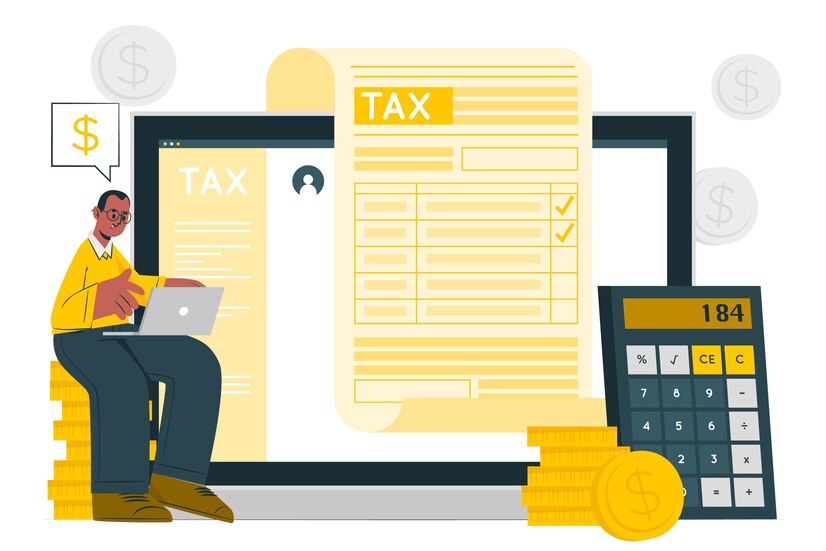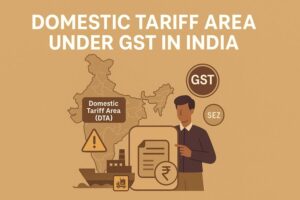A Step-by-Step Guide on GST Export Return Filing
- 9 Aug 24
- 18 mins

A Step-by-Step Guide on GST Export Return Filing
Key Takeaways
- GST has revolutionized the export sector by introducing streamlined processes and tax benefits, making Indian exports more competitive globally through zero-rated supplies and refunds on taxes paid.
- Exporters have two primary options for GST compliance: exporting goods with payment of IGST and claiming a subsequent refund, or exporting under a bond or LUT without upfront payment of IGST, each catering to different financial strategies and cash flow considerations.
- The new GST return filing system enhances the efficiency of the refund process for exports, featuring automation for faster processing, real-time tracking of refund claims, and reduced reliance on physical documentation.
- A comprehensive set of documents is required to avail GST refund, including detailed export invoices, shipping bills, bank realization certificates, and proof of IGST payment, underscoring the importance of accurate record-keeping.
- Exporters enjoy several benefits under GST, such as refunds on input tax credit and IGST paid on exports, simplified compliance procedures, exemptions from E-Way Bill requirements, and concessional GST rates under the Merchant Export Scheme, all designed to boost the competitiveness of Indian exports.
When the Goods and Services Tax (GST) was put in place in July 2017, it was a big change in India's economy and the start of a new era of unified taxes. With this complete tax reform, the complicated and layered indirect tax structure was meant to be taken apart and replaced with a system that is easier to understand and works better as a whole.
Knowing all about GST is not only helpful for the export sector, which is a big part of India's GDP and jobs, but it's also necessary.
You will also read about how Indian traders file their GST export returns. The goal of this guide is to give exporters the information they need to confidently navigate the GST landscape by breaking the process down into easy-to-understand steps, pointing out the necessary paperwork, and talking about the benefits within the GST framework.
This guide is a lighthouse for exporters who want to master the GST export return filing process. It helps them decide whether to pay IGST when they export or not, learn how to use the new return filing system, and make the most of the benefits that come with GST.
Overview of GST Refund Process for Exports under GST
As a result of making things easier and giving exporters tax breaks, India's Goods and Services Tax (GST) system has completely changed the export industry.

One of the most important parts of the GST system is that it lets people get their taxes back on things and services that are exported. This keeps Indian products from being hit with taxes from within the country. This makes Indian goods and services more competitive on the world market.
There are two main ways to get a GST return for exports that were not paid for: exporting with payment of Integrated Goods and Services Tax (IGST) and exporting without payment of IGST.
1. Send goods abroad and pay IGST
Exporters can choose to pay IGST when they send their goods or services abroad. When you use this method, you pay the IGST rate that applies to the sold goods and then get this tax amount back. The steps are easy to follow:
IGST is paid up front based on the rates that are in effect when things are exported.
Returns Must Be Filed: Next, exporters must file their GST returns, which must include specific information about the goods they sent abroad and the IGST they paid.
Refund Claim: The information in the GST reports is used to process the refund claim for the IGST paid on goods that were exported. The refund is usually sent to the exporter's bank account after the GST officials check it out.
This method is good for exporters because it makes sure that the funds' liquidity isn't greatly affected because the IGST paid on exports is refunded on time.
2. Export without paying IGST
Exporters can send goods or services outside of India without paying IGST at first, as long as they provide a Letter of Undertaking (LUT) or a bond. For keeping working capital up, this way is especially helpful:
Submission of LUT/Bond: Exporters can send goods abroad without paying IGST if they promise to meet all of their export responsibilities in a LUT or bond.
Filing of Returns: Exporters must file their GST returns, which list the goods they sent abroad but did not pay for, in the same way that they pay IGST.
Claim for return on Input Tax Credit (ITC): Since IGST is not paid when goods are exported, exporters can get a return on the input tax credit for the taxes they paid on the inputs that were used to make the goods that were exported. During this step, you have to show proof that you received the input tax credit and used it to make things that will be exported.
Both of these ways are meant to help exporters by making sure that the GST doesn't become a cost to them. This makes Indian products more competitive. Whether an exporter pays IGST taxes or doesn't pay IGST taxes relies on their cash flow, how easy it is to follow the rules, and how well they plan their finances.
How to file export GST Return?
India's Goods and Services Tax (GST) system is always changing to make it easier to follow and faster to get refunds, especially for exports. The new method for filing returns has made the GST refund process for exports more efficient. The goal is to cut down on the time and paperwork needed to process refunds.
This method is meant to make it easier for exporters to get their refunds quickly and be approved, which will help their cash flow and make their business run more smoothly. When you file your new GST return, here's a quick rundown of how to get your GST back for exports:

Step 1: Filing of Returns
Under the new GST return filing system, exporters are required to file their regular returns, which include details of their exports. The key documents involved are form GSTR-1 (details of outward supplies) and form GSTR-3B (summary return). In form GSTR-1, exporters must specifically mention their export invoices along with the shipping bill details, which are crucial for linking the exports with the payments received.
Step 2: Automated Refund Process
One of the highlights of the new return filing system is the automation of the refund process. Once form GSTR-1 is filed with complete details of the exports and matched with the corresponding entries in GSTR-3B, the system automatically processes the refund claim based on the information provided. This automation aims to eliminate manual errors and reduce the processing time for refunds.
Step 3: Real-Time Tracking
Exporters can track the status of their refund claims in real-time through the GST portal. This transparency allows exporters to plan their finances better and address any discrepancies or queries raised by the GST authorities promptly.
Step 4: Documentation and Verification
While the new system reduces the reliance on physical documentation, certain documents may still be required for verification purposes, especially in cases of discrepancies or audits. These documents include copies of invoices, shipping bills, bank realization certificates (for proving receipt of payment in foreign currency), and any other relevant export-related documents.
Step 5: Refund Sanction and Payment
Once the claim is verified and approved, the refund is sanctioned and credited directly to the bank account of the exporter. The new system aims to expedite this process, with a goal of processing refunds within a stipulated time frame, thereby enhancing the liquidity for exporters.
Documents Required for Availing GST Refund

The process of claiming a GST refund is meticulous and requires the submission of specific documents to ensure a smooth and efficient verification process. These documents serve as proof of compliance with GST regulations and substantiate the refund claim. Here is a comprehensive list of documents that are typically required for availing of a GST refund, particularly in the context of exports:
- GST Returns: Properly filed GST returns, including form GSTR-1 (details of outward supplies) and GSTR-3B (summary of supplies along with the input tax credit claimed), are fundamental. These forms should accurately reflect the export transactions.
- Export Invoices: Detailed export invoices containing information such as the GSTIN of the supplier, the name and address of the recipient, the description and quantity of goods or services, the value of goods or services, the tax amount charged, and other mandatory fields as per the GST regulations.
- Shipping Bill/Bill of Export: The shipping bill or bill of export is crucial for goods exported out of the country. It acts as a key document for customs clearance and should include details like the shipping bill number and date, which need to be mentioned in form GSTR-1.
- Bank Realization Certificate (BRC) or Foreign Inward Remittance Certificate (FIRC): These documents serve as proof of receipt of payment in foreign currency, which is essential for validating the export transaction and its value.
- Letter of Undertaking (LUT): For exports made without the payment of IGST, a copy of the LUT filed prior to the export is required. The LUT is a declaration to fulfill all requirements prescribed under GST for exporting goods or services.
- Proof of IGST Payment: If the export was made on payment of IGST, then proof of such payment is necessary. This can be in the form of challans or ledgers showing the tax payment.
- Electronic Export Ledger: This ledger, available on the GST portal, provides a record of all export transactions and taxes paid or refunded. It serves as a comprehensive document for audit and verification purposes.
- Statement of Invoices: Alongside form GSTR-1, a statement of invoices related to each shipping bill or bill of export is often required, especially when the refund claim pertains to multiple shipping bills.
- Declaration and Undertaking: A signed declaration and undertaking stating that the claimant has not availed of a refund against the shipping bill or export invoice under any other government scheme is often needed to prevent double benefits.
The GST portal and the latest notifications from the GST Council should be regularly checked for any updates or changes in the documentation requirements. Proper organization and timely submission of these documents can significantly expedite the refund process, aiding exporters in maintaining their cash flow and operational efficiency.
💡If you are looking for ways to pay your GST bill with credit card, then download Pice Business Payment App. Pice is a one stop app for all business payments.
Benefits Available to Exporters under GST
The Goods and Services Tax (GST) regime in India has been designed to support and promote export activities, recognizing the critical role exports play in the growth of the Indian economy. Under GST, several benefits have been introduced to make Indian goods and services more competitive in the global market and to simplify the tax compliance process for exporters.
Here are some of the key benefits available to exporters under GST:
- Zero-Rated Supplies: Exports are considered zero-rated under GST, allowing exporters to ship goods or services internationally without GST, keeping Indian exports competitive.
- Refund of Input Tax Credit: Exporters can claim a full refund on the Input Tax Credit for GST paid on inputs used in manufacturing exported goods, reducing production costs.
- Refund of IGST Paid on Exports: Exporters paying IGST on exported goods can claim refunds, offering flexibility in cash flow management.
- Simplified Compliance Procedures: GST has simplified procedures, including the use of a Letter of Undertaking (LUT) for IGST-free exports, easing the export process.
- Deemed Exports Benefits: Transactions classified as deemed exports, like supplies to SEZs, are eligible for tax refunds, mirroring physical export benefits.
- Electronic Ledger for Refund Claims: The GST portal's electronic ledger system streamlines the refund claim process for exporters, ensuring prompt refunds.
- E-Way Bill Exemptions: Export goods movements are exempt from certain E-Way Bill requirements, lessening the compliance load on exporters.
- Merchant Export Scheme: This scheme allows merchant exporters to procure goods at a concessional GST rate of 0.1% for export purposes, significantly lowering the tax burden on goods procurement for export.
These benefits collectively aim to enhance the ease of doing business for exporters, reduce their tax liabilities, and ensure that Indian products remain competitive on the global stage.
By leveraging these benefits, exporters can not only comply with GST regulations more efficiently but also optimize their operations for better profitability and growth in international markets.
What is E-way Bill?
The E-way Bill system is a critical component of the Goods and Services Tax (GST) framework in India, designed to facilitate the seamless movement of goods across the country. It requires the generation of an electronic waybill, or E-way Bill, for the transportation of goods valued over a certain threshold.
This system plays a significant role not just in domestic goods movement but also impacts the export sector. Understanding the import of E-way Bill data is essential for exporters for several reasons:
- Compliance with GST Regulations: The E-way Bill system ensures compliance with GST regulations during the transport of goods. Exporters must understand how to generate and manage E-way Bills to comply with tax laws and avoid penalties.
- Seamless Goods Movement: For goods being exported, the E-way Bill facilitates a smoother transportation process from the place of origin to the port of export. This reduces delays and helps in timely shipments.
- Integration with GST Returns: The data from E-way Bills is crucial for filing accurate GST returns. The details of goods transported, as mentioned in the E-way Bills, need to be reflected in the GST returns filed by exporters. This integration ensures transparency and aids in the verification process during GST audits.
- Tracking and Management: The E-way Bill portal offers features for tracking the movement of goods. Exporters can use this data to monitor their consignments in real-time, manage logistics more efficiently, and plan their operations accordingly.
- Facilitation of Refund Claims: For exports, the information from E-way Bills can be used to support refund claims, especially for the IGST paid on goods that are exported. The details in the E-way Bill serve as evidence of the movement of goods from the place of origin to the port of export.
- Record Keeping and Documentation: Maintaining a record of E-way Bills generated for the transportation of goods is essential for exporters. These records can be crucial in case of disputes or queries from tax authorities.
- Enhanced Transparency and Accountability: The E-way Bill system promotes transparency in the transport of goods. It holds all parties accountable, from the manufacturer to the transporter, ensuring that goods are moved in compliance with tax laws.
In summary, the import of E-way Bill data into the GST framework is a vital aspect that exporters need to manage diligently. It not only ensures compliance with GST regulations but also facilitates smoother logistics operations, enhances transparency, and supports the accurate filing of GST returns and refund claims.
Understanding and effectively managing E-way Bill data is, therefore, crucial for the success and efficiency of export operations under the GST regime.
What is Table 6A of Form GSTR-1?
Table 6A of Form GSTR-1 is a specific section in the GST return filing system designed for Indian exporters. It serves as a declaration form where exporters can furnish details of their exports of goods and services, including the tax invoices related to such exports. The primary purpose of Table 6A is to facilitate the refund of Integrated Goods and Services Tax (IGST) paid on goods that are exported out of India.
This table captures essential details such as the invoice number, date of invoice, GSTIN of the recipient, shipping bill number, shipping bill date, and the value of goods exported. By providing a streamlined way to report export transactions, Table 6A plays a crucial role in the GST refund process for exporters, ensuring that they can claim their IGST refunds efficiently and accurately.
Who Should File Table 6A of Form GSTR-1?
Table 6A of Form GSTR-1 must be filed by all registered taxpayers who are engaged in the export of goods and services from India. This includes:
- Regular Taxpayers: Businesses and individuals registered under GST who undertake export transactions as part of their regular trading activities.
- Merchant Exporters: Traders who buy goods from domestic suppliers and then export them. Even though they may not be the original manufacturer, they are responsible for exporting the goods and, therefore, must file Table 6A to claim refunds on the IGST paid.
- Manufacturers Exporting Goods: Manufacturers who directly export their goods out of India are required to file this table to claim the IGST refund on exported goods.
Filing Table 6A is essential for any exporter looking to claim a refund of the IGST paid on exported goods. It is a critical component of the GST return that ensures exporters can recover the taxes paid, thereby reducing their operational costs and enhancing the competitiveness of Indian goods in the global market. Proper and timely filing of Table 6A, along with accurate and comprehensive invoice details, is crucial for a smooth refund process.
 By
By 
















